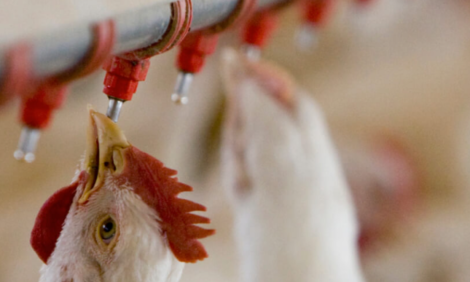



Texas A&M commits to enhance and expand Poultry Science Department
More than $850,000 in financial commitments have been designed to draw faculty and deliver infrastructure improvements to one of the US's top poultry science departments.Patrick J. Stover, Ph.D., vice chancellor of Texas A&M AgriLife, dean of the College of Agriculture and Life Sciences and director of Texas A&M AgriLife Research, announced recently that more than $850,000 in financial commitments have been designed to draw faculty and deliver infrastructure improvements. Stover also hopes to see this number grow in the future as part of the Texas A&M College of Agriculture and Life Science’s commitment to the poultry science department.

“We value the relationships built between the poultry industry and Texas A&M,” he said. “For many decades, Texas A&M has supported the industry through science and education and helped the industry improve its capacity and efficiency. These initial commitments by companies and individuals within poultry are testament to the mutually beneficial past, present and future shared by the university and our poultry partners.”
Stover said he hopes the collective commitment from the college, individual donors and corporate partners within the industry will help the university recruit and retain the best faculty, continue to grow the department’s research portfolio, provide graduate students world-class training, and attract and expand the top undergraduate class in the nation who represent the skilled workforce needed to advance the industry in Texas, the nation and globally.
Dedication to improving food systems
Public-private partnerships across the entire food value chain will continue to buttress and enhance the university’s land grant mission to develop science to create future food systems that deliver life-long human health, protect the environment and natural resources for future generations, and that ensures agriculture is economically viable for stakeholders, Stover said.
“Achieving this mission and goal for the food system will require all of Texas A&M and Texas A&M AgriLife’s expertise in research, extension, education and service and support from industry stakeholders,” he said. “For a sustainable future, we must ensure that agriculture is the solution to human health, environmental health and economic health.”
Poultry is the second largest agriculture commodity in Texas, and its continued growth and ever-changing production challenges make the Department of Poultry Science a strong partner.
J.C. Essler, executive vice president of the Texas Poultry Federation and Affiliates, said Texas A&M’s commitment to providing improved and unbiased science and well-educated, well-rounded students ready to join the workforce is invaluable to the industry.
Additionally, Essler said Texas A&M has done a great job helping the industry navigate production methodology changes that emphasize animal welfare, reducing the use of antibiotics and mitigating other challenges within the industry.
“Texas A&M has been an important partner both through science and education, and Dr. Stover’s commitment to improve an already stellar poultry program speaks volumes to the shared relationship,” he said. “As a commodity group, the Texas Poultry Federation is committed to Texas A&M’s land-grant mission, and we look forward to supporting the university’s efforts to enhance its poultry program.”
Enhancing leadership opportunities
One of the most important items of the poultry science initiative set to begin immediately is a national candidate search for a department head and instructional assistant professor. The department will continue recruitment efforts as positions are funded by donors.
Funding for the named department head position was provided by an endowment gift from Bill and Barbara Huffman. Bill Huffman ‘53 is a longtime attorney who has been recognized for his mentoring, support of programs and scholarship. He was recognized in 2017 as a Texas A&M University Association of Former Students Distinguished Alumni. The Huffman’s have made gifts to Texas A&M including support for the Corps of Cadets, Mays Business School, numerous scholarships including a President’s Endowed Scholarship, the Memorial Student Center, Kyle Field, Fish Camp and the new John D. White ’70 – Robert L. Walker ’58 Music Activities Center.
The endowment will support the department head’s research, including laboratory space, a postdoctoral researcher, graduate research assistants and undergraduate research assistants, as well as professional development and domestic and international travel.
Huffman said his experience as a poultry science student and member of the judging team specifically provided him the opportunity to learn and practice fact-based decision-making skills. Those experiences had a strong impact on his success in law school and ultimately his career as a practicing attorney.
“My experience in the department most certainly set me up for success in school, in my career and in life,” he said. “Barbara and I wanted to fund a chair who would serve Texas A&M and an exceptionally important agricultural industry – poultry – and help Dr. Stover attract the absolute best talent to continue the department’s strong legacy. Affording future students the types of experiences that led to my successes through quality faculty recruitment and retention is a true honor.”
Recruiting faculty, improving facilities to advance education and research
Other financial commitments from Merck Animal Health, the Texas Poultry Federation, Aviagen and Calpis America will help initiate the university’s efforts to improve its facilities and recruit faculty.
Shannon Kellner, vice president of U.S. Livestock Business with Merck Animal Health, said the company is proud of its long-standing partnership with the Texas A&M Department of Poultry Science. He said the industry is thankful to the department and its role in leading one of the largest food-producing industries in the world into the future through science and innovation.

“Over the years, we and others have relied heavily on the department to produce a pipeline of specialized, diverse and highly qualified candidates in the field of poultry science,” he said. “Our partnership with the department in areas of research continues to advance the poultry science industry and bring innovative solutions to address challenges.”
Rick Cozzitorto, head of U.S. sales and marketing with Huvepharma, said the Texas A&M poultry department’s focus on practical research in real-world settings and producing trustworthy data applicable to industry needs is invaluable. The department also provides a solid foundation of academic rigor for students that resonates throughout their careers in the industry.
“The department’s staff of leading experts are an asset to the industry and the land-grant system, whether it’s providing consultation and insights regarding future technologies or developing new methodology through innovative research,” Cozzitorto said. “It’s also encouraging to see professors producing high-caliber, highly educated graduates who enter the workplace and are prepared to develop into industry leaders.”
Stover said recruiting and retaining top national and international poultry science faculty is a priority for Texas A&M and that the commitments will help spark immediate efforts to fill research and education positions.
Remaining true to the land-grant mission
Stover said the future for the poultry industry is bright and that Texas A&M will remain steadfast in its commitment to the poultry industry and its mission as a land-grant institution.
Poultry meat and eggs continue to be the most consumed animal protein in the human diet, and the poultry industry has grown at an average annual rate of 5%. In Texas, poultry production created more than 33,000 jobs and contributes $33.84 billion to the economy annually. Nationally, poultry adds more than $171 billion to the economy and more than 500,000 jobs.
The poultry industry’s environmental footprint is also smaller than other protein production, and production methods accommodate small home flocks to commercial complexes, which makes poultry a flexible and economically and environmentally sustainable agriculture means to meet human health and nutrition needs around the globe.
Texas A&M expects poultry to take on an even greater proportion of animal agriculture into the foreseeable future, Stover said. Over the past five years, the department has increased external research funding 190% to $3.8 million.
Continued investment from the industry is paramount for the university to remain the most progressive national and international poultry education and research institution in the world, Stover said.
The poultry industry’s growth domestically and internationally also continues to spur enrollment, which is at an all-time high. Industry demand for those students continues to be strong with 100% job placement upon graduation.
Randy Stroud, head of global operations of Pilgrim’s Pride, said he has worked with the Texas A&M Department of Poultry Science for over 40 years in his management roles at the company.
Stroud said Pilgrim’s has relied on Texas A&M as a source for quality employees who become future leaders in the industry and consistent and applicable science-based information from its research facilities.
“We have refocused our efforts to work with Texas A&M,” he said. “We are currently exploring avenues to support research efforts at Texas A&M that would benefit the university and Pilgrim’s. I fully expect this relationship to only become stronger and more beneficial for both parties in the future.”
A tradition of excellence for poultry science students
The Department of Poultry Science is recognized nationally and internationally as the preeminent university location for poultry nutrition and intestinal health research, including collective faculty expertise ranging from genetics to intestinal physiology and microbiota in health maintenance to disease and immunology, poultry welfare, bird and waste management, and food safety.
For decades, Texas A&M has awarded more poultry science degrees than any other university in the nation. Texas A&M continues to be the most highly decorated university among six poultry programs in the nation, boasting 16 poultry judging national championships over the past 12 years.
The poultry tradition at Texas A&M sets it apart among land-grant universities, Stover said. Texas A&M’s research track record of success spearheading groundbreaking poultry science has propelled the industry’s growth and solidified its ability to meet everchanging market demands.
“Our tradition of excellence is what makes Texas A&M the best place to invest in poultry science and students,” Stover said. “We’re excited about the future of poultry science here at the university, the future of the poultry industry and engaging with our corporate partners to maximize mutual investment in our collective futures.”









